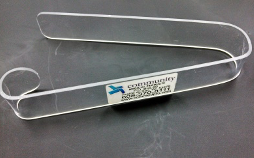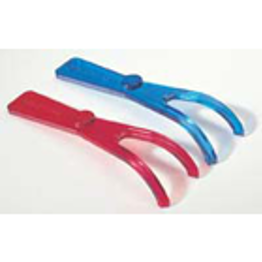Adapted Self-Care
Taking care of yourself is an important daily activity, but a stroke can make it difficult to perform. Listed below are common problems associated with self-care and solutions to help you on your road to independence. Complete the Barthel Index for Activities of Daily Living to measure your performance in daily activities.
Problems:
Hemiparesis:
This means having one side of the body weaker or more paralyzed than the other side. Self-care tasks that require two hands become more difficult. Hemiparesis can also impact safety with getting in and out of bed and performing your toileting and bathing routine.
Loss of sensation:
A stroke can cause a loss of sensation on the affected side of your body. Being unaware of water temperature, sharp items, and the position of your hand or foot can cause injury.
Vision and perception:
A stroke can cause loss of vision on your affected side and decreased awareness and attention of the affected side. It can also lead to difficulty finding objects which blend into the background and difficulty distinguishing between right and left. Vision and perceptual problems can greatly impact the ability to perform self-care activities.
Apraxia:
This means inability to plan out movements despite having the necessary range of motion, strength, and coordination. It may cause difficulty in using your unaffected arm or leg to perform self-care. Examples include placing your arms in the head-hole of a shirt, positioning a toothbrush incorrectly in the mouth, or missing your mouth when eating.
Perseveration:
A stroke can cause difficulty moving from one activity to the next. An example is bathing just one arm for 10 minutes and not moving on to bathing the rest of your body.
Memory and attention:
A stroke can cause you to forget to perform certain self-care tasks or repeat the same self-care task. An example is forgetting that you took your morning medications and taking them again. Lack of attention can cause a person to stray off-track during self-care tasks and have difficulty getting re-focused.
Solutions:
Toileting: Use your walking device and leg orthotic (AFO) when walking to and from the bathroom, install grab bars, a raised toilet seat, and a bidet on the toilet. Place a commode chair with removable bucket next to the bed. Keep wet wipes and a urinal within reach next to the bed. Use disposable underwear in case of an accident. Keep a change of clothing handy in the bathroom or with you for the unexpected.
Bathing: Install sturdy hand rails or grab bars in the tub or shower. Install non-slip flooring strips inside the tub and on the bathroom floor. Use a shower chair or tub bench. Install a hand held shower head. Place bathing supplies within easy each. Check the temperature of the bath water with your unaffected hand before getting your body wet.
Dressing: Sit in a sturdy chair to dress. Lay your clothing out in front of you to orient yourself to the position. Use a dressing checklist and check off after each task is completed. Arrange clothing items in order. Use color contrasting clothing. Dress your affected side first. Avoid tight fitting clothing. Replace buttons and laces with Velcro or magnetic fasteners. Attach key rings to zippers to make them easier to grasp.
Grooming: Use automatic soap dispensers. Use suction pads to hold grooming tools in place on counter. Use flip-open toothpaste tubes and an electric toothbrush. Use a grooming checklist and check off after each task is completed. Arrange grooming items in order. An electric razor can be safer to use.
Eating: Use silverware with larger handles or cylindrical grips that are easier to grasp. Use plate guards to keep food from migrating off the plate. Cut foods using a one-handed rocker knife. Use a shelf liner under the plate to keep it from sliding around. Place a brightly colored napkin to the left or right of the plate (your affected side) to draw attention toward the affected side. Place food on the plate using the clock-method (Meat at 12:00, Fruit at 3:00, vegetables at 6:00, starch at 9:00) and cue the person to locate all of the quadrants while eating. When eating lighter-colored foods, use a darker colored plate.
One-Handed Dressing Techniques
Putting on a Pullover Shirt With One Arm
Putting on a Sock With One Hand
Bathing

Grab Bars are easy to install increase safety in the shower.

A detachable shower head can be useful for bathing in a seated position.

A long-handled sponge allows you to clean areas that you may not be able to reach.

A shower seat/bench gives you the option to sit in your shower.

With a tub transfer bench, you can sit before lifting your legs over the edge and into the tub.

This sliding transfer bench with a swivel seat is easier for caregivers to assist patients in transferring into the tub, while providing flexible positioning.
Toileting

A bathroom hand rail acts as a grab bar to increase safety during toileting.

Long-handled wipers are useful for individuals who find it difficulty to bend, twist, or reach to wipe.

A bidet increases independence for individuals who have difficulty with or are unable to perform toileting hygiene.

A raised toilet seat is designed to help individuals sit down and get up from the toilet.

Safety frames can be placed on your toilet to increase safety and balance while seated or when getting on or off the toilet.

A bedside commode can be used when access to the bathroom is limited.
Dressing

A reacher/grabber has many uses including retrieving clothes from a closet or drawers or assisting in donning clothes.

A button hook is a tool used for one-handed buttoning of shirts, pants, and jackets.

A one-handed closure belt lets you donn a belt with only one hand.

This pant holder holds pants out of the way during self-catheterization or use of a portable urinal.

Book ring as zipper pull

This magnetic cupboard door catch can be sewn in jackets, shirts, or bras to replace
zippers or clasps. Sold in hardware stores or Amazon.com.

Magnetic door catch Msewn into a bra.

A bracelet buddy secures one end of your bracelet while you clasp the other side.

Hidden invisible sew-in magnetic snap can be sewn in jackets and coats to replace buttons. Sold at JoAnn Fabrics or Amazon.com

Tommy Hilfiger adapted clothing: magnetic closure zippers, magnetic buttons on shirts, Velcro closure pants.

The paper clip trick helps to hold one side of the bracelet in place while the other hand attaches the clasp.

Nike lace-free FlyEase sneakers

BILLY Footwear zip-on sneakers with laces

BILLY Footwear high top sneakers
Grooming

Long-handled brushes or combs are useful when an individual is unable to reach behind their head to brush their hair.

Adapted nail clippers suction to a surface for stability while a large handle helps individuals with limited fine motor coordination.

A hair dryer stand allows for hands free blow drying.

The suction nail brush secures the brush to a surface to allow for single-handed nail cleaning.

One-Handed Pony Tail Adapters

Adapted Contact Lens Holder

Long-Handled Razor
Oral Hygiene

Rolling Tube Toothpaste Squeezer

Flossmate Floss

EazyHold Adaptive Holders
Eating

Cylindrical foam tubing

Suction plate

Universal cuff for utensils

Mincing knife
Medication Management

Eye-Drop Guide

Some suggestions for medication reminder apps include: Medisafe, TabTime Vibe Vibrating Pill Timer, MedMinder, PillPack, e-pill Once-a-Day Reminder

Pill Bottle Opener

Mini Pill Box

Insulin Syringe Holder
Barthel Index for Activities of Daily Living
The Barthel Index is used to measure your performance in daily activities. A higher score is associated with more independence in your daily self-care and home management activities. The survey is anonymous and your results not shared. Reference: Mahoney FI, Barthel D. "Functional evaluation: the Barthel Index." Maryland State Med Journal 1965;14:56-61. Used with permission.
Click here to complete the Barthel Index for Activities of Daily Living.

